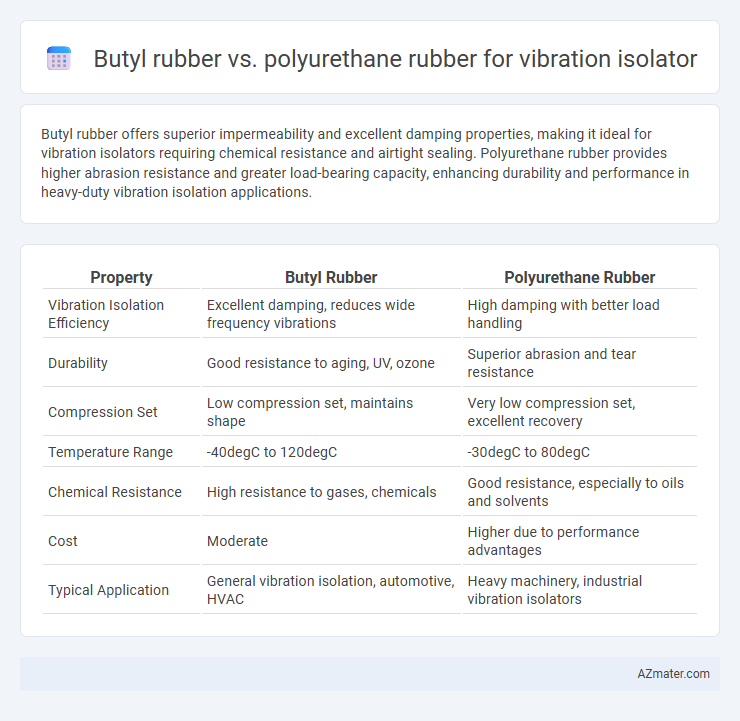Butyl rubber offers superior impermeability and excellent damping properties, making it ideal for vibration isolators requiring chemical resistance and airtight sealing. Polyurethane rubber provides higher abrasion resistance and greater load-bearing capacity, enhancing durability and performance in heavy-duty vibration isolation applications.
Table of Comparison
| Property | Butyl Rubber | Polyurethane Rubber |
|---|---|---|
| Vibration Isolation Efficiency | Excellent damping, reduces wide frequency vibrations | High damping with better load handling |
| Durability | Good resistance to aging, UV, ozone | Superior abrasion and tear resistance |
| Compression Set | Low compression set, maintains shape | Very low compression set, excellent recovery |
| Temperature Range | -40degC to 120degC | -30degC to 80degC |
| Chemical Resistance | High resistance to gases, chemicals | Good resistance, especially to oils and solvents |
| Cost | Moderate | Higher due to performance advantages |
| Typical Application | General vibration isolation, automotive, HVAC | Heavy machinery, industrial vibration isolators |
Introduction to Vibration Isolators
Vibration isolators reduce transmission of mechanical vibrations between equipment and mounting surfaces, protecting machinery and enhancing performance. Butyl rubber offers excellent damping properties and chemical resistance, making it ideal for isolators exposed to oils and solvents. Polyurethane rubber provides superior load-bearing capacity and abrasion resistance, suitable for high-impact and heavy-duty vibration isolation applications.
Overview of Butyl Rubber
Butyl rubber is a synthetic elastomer known for its excellent impermeability to gases, outstanding vibration damping properties, and superior resistance to weathering, ozone, and chemicals, making it ideal for vibration isolators in demanding environments. Its low compression set and good resilience help maintain isolation performance under dynamic loads, ensuring long-lasting durability. Compared to polyurethane rubber, butyl rubber excels in harsh conditions but typically offers lower tensile strength and abrasion resistance.
Overview of Polyurethane Rubber
Polyurethane rubber offers superior abrasion resistance, high tensile strength, and excellent load-bearing capacity, making it ideal for vibration isolator applications requiring durability and resilience. Its versatile chemistry enables tailored hardness and elasticity, enhancing energy absorption and vibration damping across a wide temperature range. Compared to butyl rubber, polyurethane provides better mechanical performance and longevity under dynamic loading conditions commonly encountered in industrial and automotive environments.
Mechanical Properties Comparison
Butyl rubber exhibits excellent damping properties and low permeability, making it ideal for vibration isolators requiring superior energy absorption and resistance to gases. Polyurethane rubber provides higher tensile strength, abrasion resistance, and load-bearing capacity, optimizing performance under heavy mechanical stress and dynamic loads. When comparing mechanical properties, butyl's elasticity and damping are superior for isolating vibrations, while polyurethane excels in durability and mechanical toughness.
Vibration Damping Effectiveness
Butyl rubber exhibits superior vibration damping effectiveness due to its high internal friction and excellent energy dissipation properties, making it ideal for isolating low-frequency vibrations. Polyurethane rubber provides enhanced durability and resilience but generally offers lower damping performance compared to butyl, especially in applications requiring significant vibration attenuation. Selecting butyl rubber for vibration isolators improves overall system stability by effectively minimizing transmitted vibration and reducing noise.
Durability and Longevity
Butyl rubber exhibits superior resistance to ozone, weathering, and chemical exposure, making it highly durable for vibration isolators in harsh environments. Polyurethane rubber offers exceptional abrasion resistance and mechanical strength, contributing to enhanced longevity under dynamic load conditions. Selecting the appropriate material depends on specific application requirements, with butyl providing longer lifespan in static or chemically aggressive settings, while polyurethane excels in high-wear, flexible applications.
Resistance to Environmental Factors
Butyl rubber exhibits superior resistance to ozone, UV rays, and weathering, making it highly durable for outdoor vibration isolators exposed to harsh environmental conditions. Polyurethane rubber offers excellent resistance to oils, solvents, and abrasion but tends to degrade faster under prolonged UV exposure and extreme weather. Selecting the optimal material depends on the specific environmental challenges, with butyl rubber favored for harsh weather resilience and polyurethane preferred for chemical and mechanical wear resistance.
Cost and Economic Considerations
Butyl rubber generally offers lower initial material costs compared to polyurethane rubber, making it a budget-friendly option for vibration isolators in large-scale applications. Polyurethane rubber, while more expensive upfront, provides superior durability and resistance to wear, potentially reducing long-term maintenance and replacement expenses. Economic considerations favor butyl rubber for short-term projects with tight budgets, whereas polyurethane is cost-effective over extended periods due to its enhanced lifespan and performance.
Application Suitability
Butyl rubber offers superior damping properties and excellent resistance to weathering, making it ideal for vibration isolators in outdoor and harsh environmental conditions. Polyurethane rubber provides higher load-bearing capacity and abrasion resistance, suitable for applications requiring durability under heavy mechanical stress. Selecting between butyl and polyurethane depends on specific application demands such as environmental exposure and mechanical load requirements.
Conclusion: Choosing the Right Material
Butyl rubber offers excellent air impermeability and chemical resistance, making it suitable for vibration isolators exposed to harsh environments and prolonged ozone exposure. Polyurethane rubber delivers superior abrasion resistance and higher load-bearing capacity, ideal for applications requiring durability and heavy-duty performance. Selecting the right material depends on application-specific factors such as environmental exposure, mechanical stress, and longevity requirements in vibration isolation systems.

Infographic: Butyl rubber vs Polyurethane rubber for Vibration isolator
 azmater.com
azmater.com